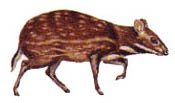Tiny deer-like mammal gave rise to whales?

The origin of whales has been a hot and intense field of study for the last several years, when it became known that whales fall within the order Artiodactyla, based on molecular data and the presence of an uniquely shaped bone in the hind foot (the astragulus) which is shared by the most primitive whales and all living and extinct artiodactyls. Artiodactyls include numerous living mammals, such as cows, camels, deer, moose and hippos. Molecular studies pointed toward the hippos in particular as the closest living relative to whales, yet paleontologists poo-poo this idea, since hippos don't show up in the fossil record until rather recently. Instead paleontologists have pointed toward the mesonychids, large carnivorous hoofed mammals as the group to give rise to whales. Whether you are in the paleontology camp or molecular camp, both camps point toward rather large ancestors for whales. Yet the most primitive whales (Pakicetus, Ichthyolestes, Artiocetus and Rodhocetus) are medium sized mammals, yet differ completely from the most primitive artiodactyl known as Diacodexis, which is a tiny small deer-like mammal that appears at the base of the Eocene. Surely there is a missing gap somewhere here. In the latest issue of Nature, J. G. M. Thewissen and colleagues plug the gap with with another small-deer like mammal Indohyus. Unlike primitive whales, Indohyus lacks the specialized reduced teeth, has slender limbs, and is small. However, Dr. Thewissen and colleagues point toward a shared trait, a thickened medial lip of the auditory bulla at the base of the skull. Of course, whales take this trait to the extreme, with greatly thickened medial lips of the auditory bulla (called a involucrum). Other traits described in the article are higher crowned teeth, and the arrangement of the incisors. Stable isotope data, seems to indicate a possible aquatic diet, and the limb bones show a thickening of the cortical bone to increase weight in an aquatic setting. Indohyus belongs to a family of artiodactyls called Roellidae, which are only known from the middle Eocene of Asia, part of the great diversification of artiodactyls toward the second half of the Eocene. It will be interesting if this alternative theory holds up to further scrutiny.
